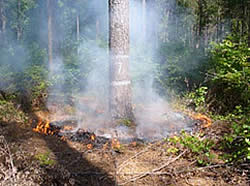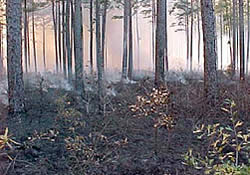
National Fire Plan Success Story
Prescribed Burning and Integrated Fuels Treatments
Bienville National Forest, Mississippi
National Fire Plan - Fuels Reduction
2007

Red-cockaded woodpecker (RCW) cavity tree.

RCW cluster site after the burn.
The Bienville National Forest is located in Central Mississippi. The Forest contains over 178,000 acres in four Counties. We have one of the largest populations of the endangered Red Cockaded Woodpecker. The maintenance of the existing clusters and hopeful expansion of the population is dependent upon prescribed fire and other activities.
The Forest averages 35,000 acres of prescribed fire treatments annually. There is increasing emphasis on the use of growing season burns to aid in the control of the invasive mid and understory species. The Forest uses other methods such as chemical treatments, mechanical mulching and commercial logging to enhance and complement the prescribed fire treatment. The use of prescribed fire to manage the landscape for the benefit of whitetail deer, wild turkey and quail is well accepted. The Forest has several natural prairies that are currently being restored to native grasses through the use of Stewardship Projects that involve total-tree chipping, herbicide treatments and the use of prescribed fire. The Forest is intermingled with privately-owned parcels that are increasingly being developed for primary dwellings or other improvements that would be threatened by wildfires without the regular treatment with prescribed fire.
Photograph 1 shows prescribed fire during the growing season. The Red Cockaded Woodpecker cavity tree has been prepared for the firing activity by removing the fuel from the base of the tree prior to being fired by hand. Photograph 2 shows an active Red Cockaded Woodpecker cluster that was burned during the dormant season for hazardous fuels. This area was previously treated with commercial total-tree chipping of the hardwood midstory species and chemical injection of the remaining understory.
Contact: Mike Dueitt, Forest Fire Management Officer, 601-965-1668 or mdueitt@fs.fed.us.